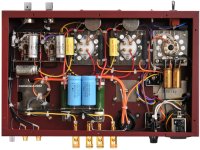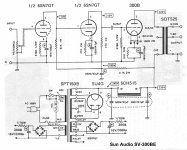Wgs57,
Correct, no negative feedback.
You are in luck!
Almost all coupling caps are used to isolate the DC voltage of a plate output, from the grid of the next stage.
Any cap leakage current ruins the design of that next stage, because the amount of designed bias voltage is destroyed (changed).
That is true for both fixed bias on the grid, fixed adjustable bias on the grid, and for grids at zero volts to accomplish self bias circuits (cathode bias).
Your 300B is using self bias, which has the combination of tradeoffs that I most prefer, versus different forms of fixed/adjustable bias and fixed bias.
$0.03
adjusted for inflation
Correct, no negative feedback.
You are in luck!
Almost all coupling caps are used to isolate the DC voltage of a plate output, from the grid of the next stage.
Any cap leakage current ruins the design of that next stage, because the amount of designed bias voltage is destroyed (changed).
That is true for both fixed bias on the grid, fixed adjustable bias on the grid, and for grids at zero volts to accomplish self bias circuits (cathode bias).
Your 300B is using self bias, which has the combination of tradeoffs that I most prefer, versus different forms of fixed/adjustable bias and fixed bias.
$0.03
adjusted for inflation
I used the SCR brand from France because I believe that is what Conrad Johnson uses in their amps. I understand it takes a long time for capacitors to settle and become one with the amp. I think I would prefer to have a capacitor that is as neutral and pure sounding as I would prefer to hear the tube coloration as opposed to the cap. But it’s whatever one prefers. I would be happy not doing this as well and leaving everything as is to be honest. There is enough tube rolling available with this amp which would provide hours of fun listening.
Oh THAT 300B amp.... Been down that road, coupling caps aren't gonna fix that one. The main issue with that design, besides VERY low power, is lack of bass response. Near field in a small room is works OK. There is no simple fix other than rewiring the driver tube topography.
Why post that Stephe? Wgs57 is happy with his amp, and system, and came here for some assistance. He didn't ask for, nor need, opinions on it.
Because likely what he is looking to improve with that amp by changing coupling caps has nothing to do with the caps. This is saving him from wasting his time and money swapping them in search of the missing bass this design has. Also realize he is not the ONLY person reading this thread, others might be reading this thinking a cap swap is going to bring out the bass response or change the power.
I could have just replied "I like Mundorf alum/oil caps" which on this design isn't going to fix it's short comings.
I could have just replied "I like Mundorf alum/oil caps" which on this design isn't going to fix it's short comings.
HI Stephe, I am a very big fan of your channel. Thanks so much for the great videos...especially on tube gear. I want to build the 6C33C tube you are currently building. I look forward to every new video you post 🙂
I don't find the bass lacking on the Sun Audio amp at all. It doesn't go thunderingly deep but neither do my speakers. In fact I have a Conrad Johnson push/pull tube amp that produces 60 watts per channel using 2-KT120's per channel that sounds similar to the 300B. I think the sound of the 300B amp is clear and the high end is very delicate and it is my preferred amp at this amp to listen to. I am an SET fanboy now! I listen to mostly jazz, new age, classical and instrumental by streaming with Qobuz and playing CD's. The Yamaha NS-1000M's that I love aren't the most efficient but I can play the music very loud and the bass is satisfying. My Belle Klipsch's are wonderful as well with the 300B.
I just thought it could be fun to pass my time by swapping out coupling capacitors and listening for different sound qualities...like swapping tubes can provide a different a sound colour. I wasn't looking for a larger low end.
I don't find the bass lacking on the Sun Audio amp at all. It doesn't go thunderingly deep but neither do my speakers. In fact I have a Conrad Johnson push/pull tube amp that produces 60 watts per channel using 2-KT120's per channel that sounds similar to the 300B. I think the sound of the 300B amp is clear and the high end is very delicate and it is my preferred amp at this amp to listen to. I am an SET fanboy now! I listen to mostly jazz, new age, classical and instrumental by streaming with Qobuz and playing CD's. The Yamaha NS-1000M's that I love aren't the most efficient but I can play the music very loud and the bass is satisfying. My Belle Klipsch's are wonderful as well with the 300B.
I just thought it could be fun to pass my time by swapping out coupling capacitors and listening for different sound qualities...like swapping tubes can provide a different a sound colour. I wasn't looking for a larger low end.
Stephe, I did see that video you posted several months ago but I did not clue in that the schematic for my Sun Audio SV-300BE is the same as with the Boyuurange or Nobsound. That really is disappointing because this amp is Japanese made and I hold their gear in high regard. I need to find me a scope to see if I am getting similar reading before the mods. I guess this schematic has been used in many builds, whether it's made from the US, Japan, Canada, Eastern Europe or China.Oh THAT 300B amp.... Been down that road, coupling caps aren't gonna fix that one. The main issue with that design, besides VERY low power, is lack of bass response. Near field in a small room is works OK. There is no simple fix other than rewiring the driver tube topography.
It's the dominant schematic of commercially available 300b amps. And universally panned on this website.
Dubadub...can you help me understand why this schematic design is panned? I guess there must be a long long discussion on this schematic here on DIYAUDIO. I think I have opened up a can of worms for me. I do want to know though as everyone's thoughts are important.
That link you provided was more for the Boyuurange amp. The schematic for my amp is different in areas. Stephe from Skunkie Designs has a modified version of my amp that I will research more on, but not until I get a scope attached to my amp to see if I get the same results as she initially did before her mods.
Attachments
I wouldn't worry about getting a scope for confirmation. The bass response is completely defined by
the output transformers and the various electrolytic capacitors in the circuit. Just verify you have the same OTs.
the output transformers and the various electrolytic capacitors in the circuit. Just verify you have the same OTs.
And the Japanese amp will have much better output transformers (we hope) compared to the Boorange amp.The bass response is completely defined by the output transformers
jeff
The Sun Audio amps use Tamura transformers and they have been around a very long time I have read…since 1924.
I've built that "Sun/JC Morrison" circuit with good OT, and the power and low frequency response didn't change. If the front end can't produce the voltage swing needed, changing the OT won't fix the issue. So no, the idea that a good OT will cover up a circuit problem.And the Japanese amp will have much better output transformers (we hope) compared to the Boorange amp.
jeff
This statement that "The bass response is completely defined by the output transformers and the various electrolytic capacitors in the circuit" doesn't mirror what I have seen working on various amps. When I first started working on my "Budget 300B amp" project and was using this schematic, multiple people on this forum warned me not to. They were right. switching from this cascade to a cascode transformed the performance of the amp and dozens of people have either built that amp and/or modified the A50 and concur.
Stephe, While this circuit is lacking, there is potential challenge here. What front-end circuit could it be replaced with while keeping the 'optics' of the amplifier the same?
In other words, keep an octal dual triode - maybe a dissimilar triode? I might check out the 6EM7...6EA7... or maybe a single triode octal input tube with MOSFET follower 'under the hood'?
In other words, keep an octal dual triode - maybe a dissimilar triode? I might check out the 6EM7...6EA7... or maybe a single triode octal input tube with MOSFET follower 'under the hood'?
Last edited:
The cascode I have used with these amps use the same tubes that are there, just a cascode instead of a cascade.

The cascode I have used with these amps use the same tubes that are there, just a cascode instead of a cascade.
If You could draw the Cascode schematic little different the difference would be more obvious to beginners - meaning the words are similar so the cascAde are two stages in series but the cascOde is one stage with two triode sections.
I've looked at the both video clips tonight - from what scope shows it is pretty clear that cascade can't really drive 300B properly even with higher DC voltage developed over tube itself - but after seeing what the scope shows Your solution is clearly better.
Looking under the hood and tracing the topology without the schematic can sometimes be hard for beginners even with the pcb ( if such exists ) but with the schematic this should be easier ( or after few builds ) - if the Amp really has the upper schematic than chaging it to Yours, lower schematic should be pretty easy with basic skills.
Thannks & regards, Krca
- Home
- Amplifiers
- Tubes / Valves
- Swapping Audio Coupling Capacitors in a Tube Amp

